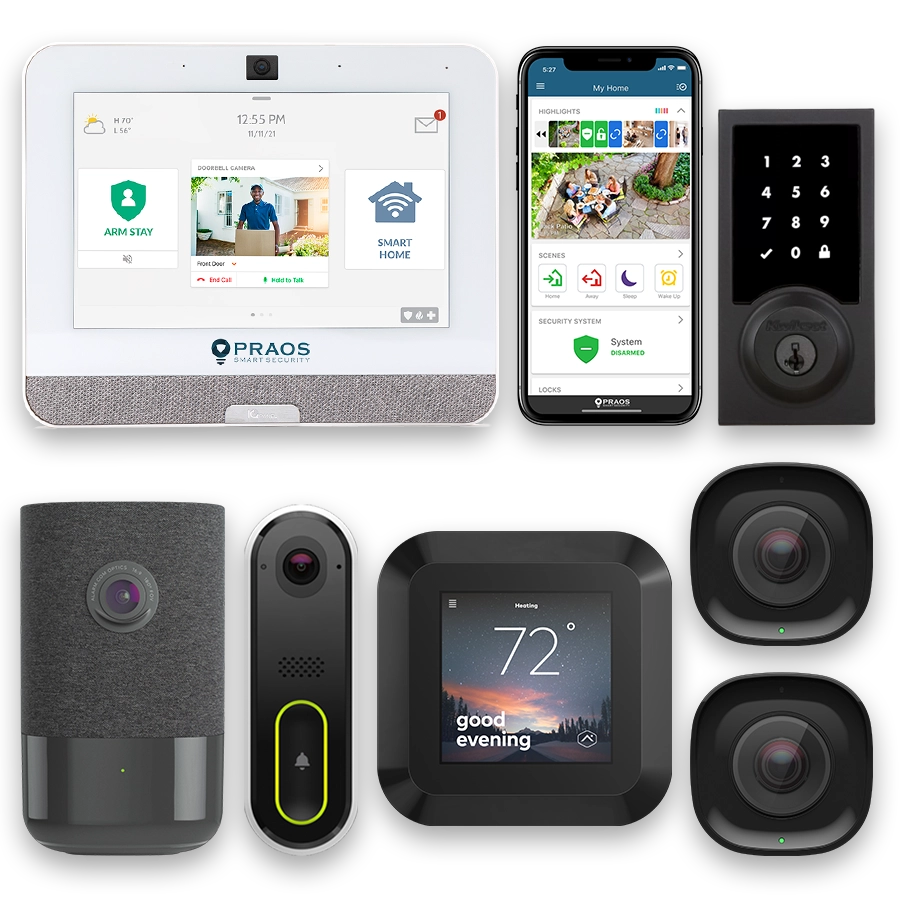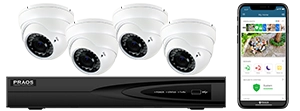The Evolution of Alarm Monitoring Systems
Alarm monitoring systems have undergone significant changes since their inception. These changes reflect advancements in technology and growing security needs, both for residential, and commercial applications.
Initially, alarm systems were simple mechanical devices that relied on physical elements triggering an alert. For example, trip wires and pressure mats would activate alarms when disturbed. Over time, these rudimentary systems evolved to include electrical components, where basic circuits detected interruptions and triggered alarms.
In the mid-20th century, telephone-based monitoring began to gain popularity. These systems were capable of dialing pre-set phone numbers to alert homeowners or business owners when an alarm was triggered. This period also saw the introduction of central monitoring stations, where dedicated staff would receive alarms and take appropriate action, such as contacting emergency services.
By the 1980s, the advent of computer technology revolutionized alarm monitoring systems. Microprocessors were introduced to enhance the processing power of alarm systems, allowing for more sophisticated detection mechanisms and the ability to monitor multiple sensors simultaneously. During this era, electromagnetic and infrared detectors became more common, providing more accurate and reliable intrusion detection.
With the rise of the Internet in the late 20th and early 21st centuries, alarm monitoring systems experienced another leap forward. Internet Protocol (IP)-based alarm monitoring allowed for real-time data transmission over the internet, enabling faster and more efficient monitoring and response times.
Today, modern alarm monitoring systems leverage advanced technologies such as wireless communication, smartphone integration, and artificial intelligence (AI). These innovations provide enhanced functionality, ease of use, and improved accuracy in detecting threats. The integration of AI, for example, enables systems to differentiate between false alarms and genuine security breaches, reducing the chances of unnecessary alerts.
The following table summarizes key milestones in the evolution of alarm monitoring systems:
| Era | Technological Advancements |
|---|---|
| Mechanical Age | Mechanical trip wires and pressure mats |
| Electrical Age | Basic electrical circuits for detection |
| Telephone Age | Telephone-based monitoring and central stations |
| Computer Age | Microprocessors, electromagnetic and infrared detectors |
| Internet Age | IP-based monitoring, wireless communication, AI integration |
The continuous evolution of alarm monitoring systems underscores the importance of adapting to new technologies to maintain effective home and business security. These advancements ensure that alarm systems remain an integral component in protecting lives and property.
Key Technologies in Modern Alarm Monitoring
Alarm monitoring systems have significantly advanced over the years, incorporating various cutting-edge technologies to enhance security for both homes and businesses.
One of the key technologies in modern alarm monitoring systems is wireless communication. Wireless alarm systems eliminate the need for extensive wiring, making installation easier and more flexible. They use secure radio frequencies to transmit signals, which ensures that the system remains functional even in the event of cut wires or physical tampering.
Video surveillance is another crucial component. Modern alarm systems often integrate high-definition cameras with features such as night vision, motion detection, and remote access. These systems provide real-time video feeds and recorded footage, which can be accessed via smartphones or computers. Such capabilities allow users to monitor their premises at any time, from any location.
Additionally, smart sensors play an imperative role. These sensors include motion detectors, door and window sensors, glass break detectors, and environmental sensors detecting smoke, fire, carbon monoxide, or flooding. They are designed to immediately notify users and monitoring centers of any unusual activities or hazardous conditions.
Cloud-based monitoring and data storage is also transforming how alarm systems operate. By storing data on the cloud, users are able to access logs, alarm reports, and video footage without the risk of local data loss. This secure and efficient data management method ensures that critical information is always available for review and analysis.
Another significant advancement is the incorporation of Artificial Intelligence (AI) and Machine Learning (ML) into alarm monitoring systems. AI and ML enable systems to learn patterns over time, distinguish between normal and suspicious activities, and even predict potential security breaches before they occur. This intelligent monitoring reduces false alarms and enhances overall effectiveness.
The integration of mobile applications has enhanced the convenience and control users have over their security systems. Mobile apps allow users to arm or disarm their systems remotely, receive instant notifications, and control other smart home devices such as lights and thermostats. This integration creates a holistic, user-friendly security solution.
Two-way audio communication is another beneficial technology. It allows direct communication between the user and the monitoring center or even with an intruder or visitor through built-in microphones and speakers in cameras or control panels. This feature can deter potential intruders and enable efficient handling of security events.
Lastly, the incorporation of redundant monitoring channels ensures continuous operation even if one communication pathway is compromised. These systems can automatically switch to alternative channels, such as cellular networks, to maintain constant contact with monitoring centers, thus enhancing reliability and security.
Benefits of Alarm Monitoring for Home Security
Alarm monitoring systems provide numerous benefits for home security. These systems offer continuous surveillance, ensuring that any security breach is promptly detected and reported. Such vigilance is crucial for the safety of residents and protection of property.
One of the primary benefits of alarm monitoring is the rapid response to emergencies. Monitoring centers are staffed 24/7, allowing for immediate action. According to data from the Electronic Security Association (ESA), homes with monitored systems are 300% less likely to be burglarized compared to those without a security system.
Another benefit of alarm monitoring systems is their ability to provide comprehensive coverage. These systems often include burglar alarms, fire alarms, and environmental sensors such as carbon monoxide detectors. This comprehensive approach ensures that various types of threats are detected and mitigated swiftly.
Insurance companies often provide discounts on homeowner’s insurance for properties equipped with alarm monitoring systems. This is because the presence of these systems reduces the risk of theft, fire, and other damages, leading to lower insurance claims. The Insurance Information Institute states that homeowners can save as much as 20% on their premiums.
The following table provides a summary of some key benefits of alarm monitoring systems for home security:
| Benefit | Details |
|---|---|
| Rapid Response | Immediate action by monitoring centers, 24/7 service |
| Comprehensive Coverage | Includes burglar, fire, and environmental alarms |
| Insurance Discounts | Potential savings of up to 20% on premiums |
Additionally, alarm monitoring systems are continually advancing with technology, offering features like remote access via smartphones. Homeowners can monitor their security systems in real-time, receive alerts, and even control some aspects of their home security remotely. This capability adds a layer of convenience and reassurance for individuals who travel frequently or have irregular schedules.
It is also worth noting that the deterrent effect of visible alarm monitoring reduces the likelihood of crime. Studies have shown that the mere presence of alarm systems can prevent criminal activities. Criminals often avoid homes with visible security measures, preferring easier targets.
In conclusion, the benefits of alarm monitoring for home security are significant and multifaceted. From enhanced safety and insurance savings to the convenience of modern technology, these systems offer a robust defense against various threats, making them a valuable investment for any homeowner.
Importance of Alarm Monitoring in Business Security
Alarm monitoring plays a crucial role in business security by providing real-time surveillance and immediate response to potential threats. This is particularly important in safeguarding valuable assets, sensitive information, and ensuring the safety of employees and customers.
1. Asset Protection: Businesses often store valuable items, such as equipment, inventory, and proprietary information, which need constant protection. Alarm monitoring systems can detect unauthorized access or suspicious activities, thereby reducing the risk of theft and vandalism.
2. Enhanced Employee Safety: Monitoring systems not only protect physical assets but also contribute to the safety of employees. In the event of a break-in, fire, or other emergencies, alarm systems can quickly notify authorities, facilitating a rapid response that could be vital in protecting human lives.
3. 24/7 Monitoring and Response: With professional monitoring services, businesses benefit from around-the-clock surveillance. This continuous monitoring ensures that any irregularities are swiftly identified and addressed, regardless of the time of day.
4. Regulatory Compliance: Many industries have stringent security requirements and regulations. Implementing an effective alarm monitoring system can help businesses comply with these standards, avoiding potential legal and financial repercussions.
5. Insurance Benefits: Insurance companies often consider the presence of an alarm monitoring system as a risk mitigation measure. This can result in lower insurance premiums for businesses, thereby reducing overall operational costs.
6. Reduction of Operational Downtime: Security breaches can lead to significant interruptions in business operations. By preventing such incidents, alarm monitoring systems help maintain continuity, ensuring that business activities run smoothly without unexpected disruptions.
7. Deterrent Effect: The mere presence of a comprehensive alarm system can act as a deterrent to criminal activities. Potential intruders are less likely to target a business with visible and robust security measures in place.
In conclusion, the importance of alarm monitoring in business security cannot be overstated. It provides a multi-faceted approach to protecting assets, ensuring employee safety, maintaining regulatory compliance, and mitigating risks—all of which contribute to the overall stability and success of a business.
Challenges and Solutions in Alarm Monitoring
Alarm monitoring systems play a critical role in safeguarding properties, yet they face several challenges that can impact their effectiveness. Understanding these challenges and implementing appropriate solutions is vital for optimizing security measures.
Common Challenges in Alarm Monitoring
One of the primary challenges is false alarms. According to the Electronic Security Association (ESA), false alarms account for 95-98% of all alarm activations. These false alarms can be caused by user error, technical issues, or environmental factors.
Another significant challenge is the reliability of communication methods. Alarm systems often rely on internet connectivity or phone lines to communicate with monitoring centers. Interruptions in these communication channels, whether due to technical failures or deliberate tampering, can hinder response times.
Integration with other security systems poses another challenge. Ensuring that alarm monitoring systems seamlessly integrate with surveillance cameras, access control systems, and other security infrastructure is necessary for comprehensive security but can be technically complex.
Solutions to Overcome Challenges
- To reduce false alarms, proper user training and regular system maintenance are essential.
- Utilizing redundant communication channels can enhance the reliability of alarm notifications.
- Advanced technologies such as video verification can help distinguish between real threats and false alarms, thereby reducing unnecessary dispatches.
- Adopting standardized protocols and employing professional integration services can ensure compatibility among different security systems.
Table: Common Challenges and Solutions in Alarm Monitoring
| Challenge | Solution |
|---|---|
| False Alarms | User training, regular maintenance, video verification |
| Reliability of Communication Methods | Redundant channels (e.g., cellular backup) |
| Integration with Other Systems | Standardized protocols, professional integration |
By addressing these challenges through strategic measures and leveraging modern technologies, the effectiveness of alarm monitoring systems can be significantly enhanced, thereby providing greater security to homes and businesses alike.
Future Trends in Alarm Monitoring Technologies
As technology continues to advance, alarm monitoring systems are expected to evolve significantly in the coming years. Several emerging trends are anticipated to shape the future of these systems, enhancing their efficiency, reliability, and integration capabilities.
1. Artificial Intelligence and Machine Learning
One of the most promising trends in alarm monitoring is the integration of artificial intelligence (AI) and machine learning (ML). These technologies enable alarm systems to analyze vast amounts of data, identify patterns, and make decisions with minimal human intervention. AI can improve the accuracy of alarm detection, reducing false alarms and ensuring a quicker response to genuine threats.
2. Internet of Things (IoT) Integration
The Internet of Things (IoT) is another trend likely to impact alarm monitoring. IoT devices, such as smart cameras, sensors, and home automation systems, can be integrated with alarm monitoring systems to provide more comprehensive security solutions. By leveraging IoT, homeowners and businesses can achieve real-time monitoring and control through connected devices.
3. Cloud Computing and Storage
Cloud computing plays a crucial role in the future of alarm monitoring. Storing data in the cloud offers significant advantages, such as scalability, remote access, and improved data security. It enables easier integration with other security services and ensures that critical data is accessible even if local systems are compromised.
4. Cybersecurity Measures
As alarm systems become more interconnected, the importance of cybersecurity increases. Future alarm monitoring technologies will need to incorporate advanced cybersecurity measures to protect against hacking and other cyber threats. This includes encryption, regular software updates, and secure network protocols.
5. Mobile and Remote Access
The growing trend of remote access is transforming how alarm systems are monitored and managed. Through mobile applications, users can receive real-time alerts, view live footage, and control their systems from anywhere in the world. This ensures enhanced security and convenience for both residential, and commercial users.
6. Predictive Analytics
Predictive analytics uses historical data to predict potential security breaches before they occur. By analyzing trends and patterns, predictive analytics can forecast possible security events and trigger preemptive actions. This proactive approach can significantly enhance the effectiveness of alarm monitoring systems.
Example Table of Emerging Alarm Monitoring Trends
| Trend | Key Advantage |
|---|---|
| AI and ML | Improved accuracy and reduced false alarms |
| IoT Integration | Comprehensive security through connected devices |
| Cloud Computing | Enhanced data security and remote access |
| Cybersecurity | Protection against hacking and cyber threats |
| Mobile Access | Real-time monitoring and control from anywhere |
| Predictive Analytics | Proactive threat prevention |
In conclusion, the future of alarm monitoring technologies promises significant advancements that will improve both home and business security. By embracing these trends, alarm monitoring systems can become more efficient, responsive, and robust in defending against evolving threats.





